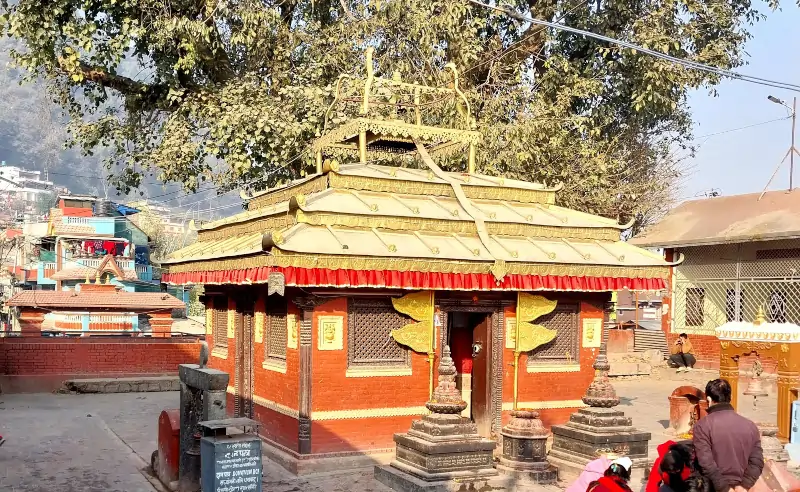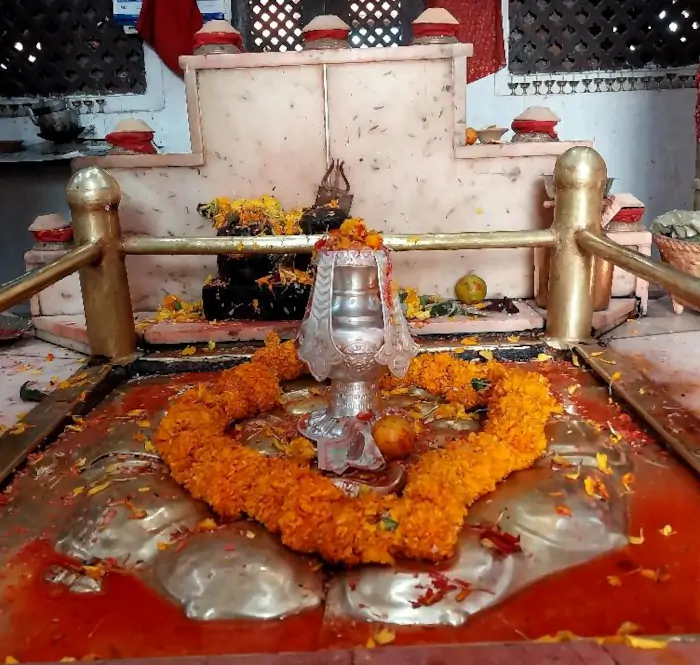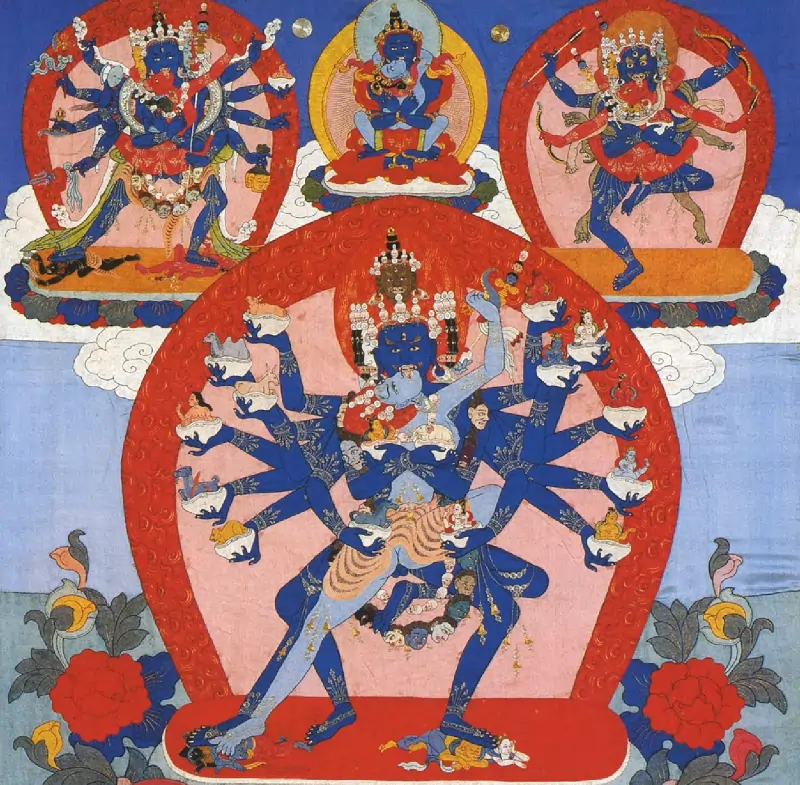The Spiritual Essence of Bajracharya Buddhism: Embracing Hevajra & Nairatmya
In the heart of Bajracharya Buddhism, a tradition rich in history and spiritual depth, lies the profound reverence for Hevajra and Nairatmya. These deities are not mere figures of worship but pivotal symbols in the spiritual tapestry of this tradition. Bajracharya Buddhists engage in dedicated prayers and rituals to these deities, viewing them as essential guides on the path to enlightenment. The inclusion of Hevajra and Nairatmya in their practices underscores a deep connection to the principles of Vajrayana Buddhism, where these figures hold significant roles.
Hevajra Tantra: The Guiding Light of Vajrayana Practice
The Hevajra Tantra is a pivotal text in Vajrayana Buddhism, revered for its profound teachings on spiritual practices and enlightenment. This scripture serves as a comprehensive guide for meditation, rituals, and understanding the symbolism of the deity Hevajra. Central to its teachings is the concept of embracing wisdom and method to achieve spiritual awakening. The text delves into detailed descriptions of meditative visualizations, mantras, and the intricate symbolism of Hevajra’s form, which is seen as a path to understanding deeper cosmic truths. The Hevajra Tantra is not just a religious manuscript but a spiritual map guiding practitioners towards enlightenment, emphasizing the transformation of the mind and spirit. Its teachings are essential in the practice of Tantric Buddhism, offering a profound insight into the journey of self-realization and the transcendence of ego and ignorance.
Hevajra: The Blue-Hued Master of Enlightenment
Hevajra, the male deity, in Sanskrit हेबज्र, the name signifies “Hail to the Vajra”, a prominent figure in Newar Buddhism, is deeply rooted in the Hevajra Tantra of Vajrayana Buddhism. This deity is a symbol of a profound union of two essential spiritual elements: great compassion, represented by “He,” and wisdom, symbolized by “Vajra.” The name Hevajra itself encapsulates the complete essence of wisdom and compassion. This synthesis is vital in Vajrayana Buddhist practices, where the combination of compassion and wisdom is seen as the key to enlightenment.
Hevajra is portrayed as a fierce deity, featuring eight heads, sixteen arms, and four legs, each aspect holding symbolic meaning. Among his multiple arms, two are dedicated to embracing his consort, Nairatmya, signifying the union of wisdom and emptiness. His dark blue complexion and radiant aura convey a sense of deep spiritual power. Hevajra’s red eyes and yellow hair, coiled and knotted atop his head, add to his formidable appearance. The deity is adorned with Pancamudra, consisting of five ornaments – the circlet, earrings, necklace, wrist bracelets, and girdle. Each of these represents the purified aspects of the five delusions, a key concept in Buddhist teachings. Additionally, Hevajra’s wrathful appearance is accentuated by his tiger skin attire, and he is often shown holding a skull in his left hand and a black vajra in his right, with a khatvanga resting on his left shoulder. These elements underscore the deity’s role as a destroyer of ignorance, embodying the transformative power of enlightenment. Originating from the seed syllable ‘hum’, Hevajra’s imagery is a vivid representation of the spiritual journey in Vajrayana Buddhism, from the darkness of ignorance to the radiance of enlightened wisdom and compassion.
Nairatmya: The Embodiment of Transcendent Wisdom
Nairatmya, the female deity, in Sanskrit नैरात्मा, in Nepal popularly known as Guheswari (गुहेस्वरी), whose name Nairatmya in Sanskrit translates to “No-Self” or “Non-Ego,” is a significant deity in Newar Buddhism, symbolizing profound philosophical concepts. Her name itself embodies a core principle of Buddhism: the recognition and understanding of the non-existence of a permanent, unchanging self or ego. This concept is central to Buddhist teachings, emphasizing the transient nature of existence and the importance of overcoming the individual ego to attain spiritual enlightenment. Nairatmya’s role in the pantheon is not just emblematic but integral to the understanding and practice of Buddhist wisdom, particularly the wisdom of non-duality. Her association with the transcendence of the ego and the realization of emptiness reflects key aspects of Buddhist philosophy, focusing on the interdependence and impermanence of all things and the ultimate nature of reality.
Nairatmya is presented with dark blue skin, indicative of the depth and mystery of the wisdom she embodies. She has one face and two hands, which hold a curved knife and a skullcup at her heart, while a khatvanga staff rests against her left shoulder. These items are not mere adornments but are laden with symbolic meaning, representing various aspects of enlightenment and the transcendental wisdom she personifies. Nairatmya is adorned with a tiara of skulls and bone ornaments, further emphasizing her connection to the cycle of life, death, and rebirth, as well as the transcendence of worldly attachments. The skirt made of tiger skin signifies her semi-wrathful nature, a common theme in Newar iconography to represent the power to overcome obstacles on the path to spiritual awakening. As the consort of Hevajra, another prominent deity in Newar Buddhism, Nairatmya plays a pivotal role in the spiritual narrative, representing a harmonious balance between wisdom and compassion, a fundamental aspect of the Buddhist path towards enlightenment.
Recognizing Hevajra and Nairatmya
To recognize Hevajra and Nairatmya, observe that Hevajra is portrayed in dark blue, with multiple heads and arms, and a fierce expression, embracing Nairatmya, who is depicted in light blue, with a single head, standard hands and legs, and adorned in tiger skin.
Purano Guheswari: Hevajra & Nairatmya Temple in Kathmandu
In the serene vicinity of Balaju, Kathmandu, Nepal, stands the ancient Purano Guheswari Temple, a revered site steeped in spiritual history. Believed to have been built by Mahasiddhi Paramadi Bajra Bajracharya, a distinguished figure from Kwabahal, Kathmandu, the temple is a significant landmark in the city’s religious landscape. It is dedicated to the deity Nairatma, known here as Guheswari, alongside Hevajra. The name ‘Purano Guheswari’ itself holds a special meaning, signifying the temple as the ‘old and original’ Guheswari temple in Kathmandu, distinguishing it from later establishments. This temple not only serves as a place of worship but also as a testament to the rich spiritual heritage and cultural tapestry of Kathmandu, drawing devotees and historians alike to its sacred grounds. See in Map


Conclusion: Embracing the Depth of Buddhist Symbolism
In summary, Hevajra and Nairatmya stand as profound symbols in both Newar Buddhism. These deities, through their fierce and complex representations, invite followers into a deeper understanding of Buddhist teachings, emphasizing the transformation of negative emotions and the realization of non-self. The Hevajra Tantra serves as a vital guide in this journey, providing insights into the rituals and symbolism that define these practices. Together, Hevajra and Nairatmya encapsulate the essence of Buddhist wisdom, guiding devotees towards a more profound and transcendent understanding of their spiritual path.
Reference
- The Iconography of Nepalese Buddhism, Min Bahadur Shakya, 1994
- Prasiddha Bajracharya, Badri Ratna Bajracharya, 1988
- Explaining Nairatmya, Mandalas.life
- Hevajra, wisdomlib.org

